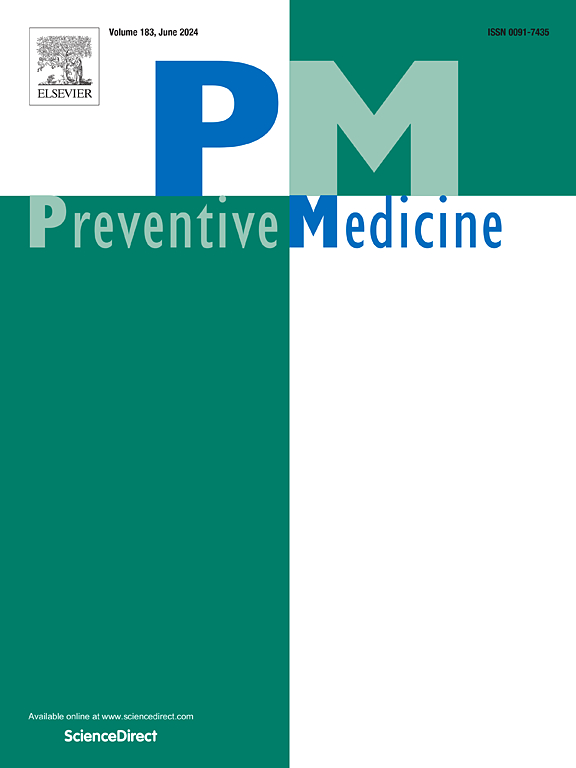Temporary urban environment changes to promote physical activity in urban populations: A scoping review
IF 3.2
2区 医学
Q1 MEDICINE, GENERAL & INTERNAL
引用次数: 0
Abstract
Objective
To examine what is known about the role of Temporary Urban Environment Changes (TUECs) in promoting physical activity in urban contexts.
Methods
We conducted a scoping review in line with the Preferred Reporting Items for Systematic Reviews and Meta-Analyses extension for Scoping Reviews. We systematically searched MEDLINE (Ovid), Web of Science, PubMed, SPORTDiscus, CINAHL, Scopus and PsycINFO, with screening and selection based on predefined criteria. Searches were completed in September 2024.
Results
Forty-two studies met the inclusion criteria, mostly published after 2019 and set in high- income countries (primarily the United States and Europe). Five TUECs categories were identified: Open/Play Streets and Ciclovía, pop-up cycle lanes, pop-up parks, parklets/plazas, and other. Walking and cycling were the most frequently supported activities; 38 studies reported a beneficial direction of effect on physical activity and 4 were inconclusive. The evidence base is dominated by observational or cross-sectional designs, with inconsistent theoretical framing and heterogeneous physical-activity measures (mostly self-report or on-site observation, with few device-based measures). Equity dimensions, including reach among inactive groups, deprivation, disability and age, were rarely examined.
Conclusion
TUECs offer a flexible and increasingly relevant approach to supporting physical activity in urban environments. This review consolidates a fragmented evidence base and proposes a coherent lens for understanding how temporary spatial interventions are conceptualised, operationalised, and evaluated. As urban areas seek scalable, health-oriented solutions, TUECs deserve closer attention—not as isolated experiments, but as strategic tools within broader public health and urban planning agendas.
临时城市环境变化促进城市人口身体活动:范围综述
目的:研究在城市环境中,临时城市环境变化(TUECs)在促进身体活动中的作用。方法:我们根据系统评价的首选报告项目和范围评价的元分析扩展进行了范围评价。我们系统地检索了MEDLINE (Ovid)、Web of Science、PubMed、SPORTDiscus、CINAHL、Scopus和PsycINFO,并根据预先设定的标准进行筛选和选择。搜寻工作于2024年9月完成。结果:42项研究符合纳入标准,主要发表于2019年之后,并设置在高收入国家(主要是美国和欧洲)。确定了五个TUECs类别:开放/游戏街和Ciclovía,弹出式自行车道,弹出式公园,小公园/广场等。步行和骑自行车是最常被支持的活动;38项研究报告了对身体活动的有益影响,4项研究尚无定论。证据基础主要是观察性或横断面设计,具有不一致的理论框架和异质性的身体活动测量(主要是自我报告或现场观察,很少有基于设备的测量)。公平方面,包括在不活动群体、贫困、残疾和年龄之间的接触,很少得到审查。结论:tuec为支持城市环境中的身体活动提供了一种灵活且日益相关的方法。这篇综述整合了支离破碎的证据基础,并提出了一个连贯的视角来理解临时空间干预措施是如何概念化、操作化和评估的。随着城市地区寻求可扩展的、以健康为导向的解决方案,tuec应该得到更密切的关注——不是作为孤立的实验,而是作为更广泛的公共卫生和城市规划议程中的战略工具。
本文章由计算机程序翻译,如有差异,请以英文原文为准。
求助全文
约1分钟内获得全文
求助全文
来源期刊

Preventive medicine
医学-公共卫生、环境卫生与职业卫生
CiteScore
7.70
自引率
3.90%
发文量
0
审稿时长
42 days
期刊介绍:
Founded in 1972 by Ernst Wynder, Preventive Medicine is an international scholarly journal that provides prompt publication of original articles on the science and practice of disease prevention, health promotion, and public health policymaking. Preventive Medicine aims to reward innovation. It will favor insightful observational studies, thoughtful explorations of health data, unsuspected new angles for existing hypotheses, robust randomized controlled trials, and impartial systematic reviews. Preventive Medicine''s ultimate goal is to publish research that will have an impact on the work of practitioners of disease prevention and health promotion, as well as of related disciplines.
 求助内容:
求助内容: 应助结果提醒方式:
应助结果提醒方式:


